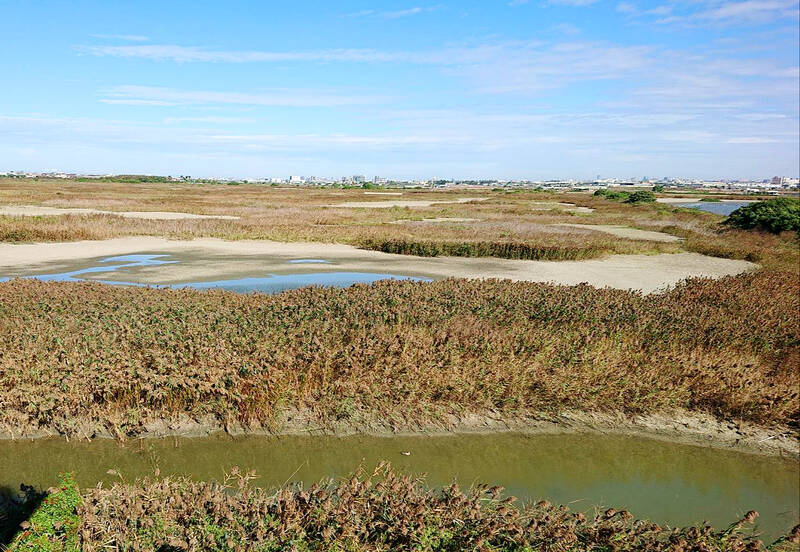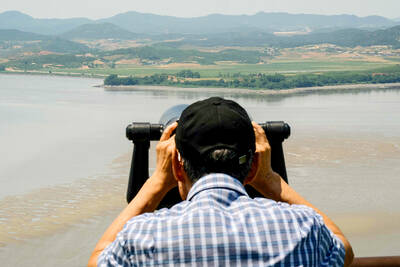In much of the world, including Taiwan, May 13 is World Migratory Bird Day, which aims to increase public awareness of the threats facing wild bird populations.
Taiwan’s importance to migrating avians is widely known. It’s one of the reasons why birdwatching enthusiasts fly thousands of kilometers to see birds here. The country lies at the heart of the East Asian-Australasian Flyway, which covers a huge area from the Arctic to New Zealand. Each year, more than 50 million waterbirds migrate vast distances along the flyway.
Taiwan’s coastal wetlands, salt flats, paddy fields, fish farms, flood detention ponds and lakes are key relay points on the flyway, Lin Kun-hai (林昆海), director-general of the Kaohsiung Wild Bird Society (高雄市野鳥學會) says.

Photo courtesy of Wild Bird Society of Tainan
For Taiwan, the theme of this year’s World Migratory Bird Day couldn’t be more timely and relevant. According to www.worldmigratorybirdday.org, the “campaign will focus on the topic of water and its importance for migratory birds … Inland and coastal wetlands, rivers, lakes, streams, marshes and ponds are all vital for feeding, drinking, or nesting and also as places to rest and refuel during their long journeys. Unfortunately, aquatic ecosystems are becoming increasingly threatened around the world and so are the migratory birds that depend on them.”
For the second time in three years, Taiwan is experiencing a severe drought — and it’s not been good for visiting or resident avians.
LACKING RESOURCES

Photo: Yang Chin-cheng, Taipei Times
Lin describes the Wetland Conservation Act (濕地保育法), which took effect on Feb. 2, 2015, as “a milestone in wetland protection.” But, he adds that the funds and manpower invested by the government in wetland conservation have been “seriously insufficient.”
As a result, some wetlands are ill-prepared for extreme weather events such as the current drought, he says. One of them, Cieding Wetland (茄萣濕地) in the northwestern corner of Kaohsiung, has almost dried out in recent months.
The wetland was originally a set of salt flats. Like most places in Taiwan where salt was made by evaporating seawater, it was slightly below sea level so the fields could be easily flooded.

Photo courtesy of birder surnamed Wang
However, Lin says when the government developed Singda Harbor (興達港) into a base for offshore fishing, sand dredged from the bottom of the harbor was dumped on the salt fields. This created the wetland, but because it’s now higher than sea level, it can only be replenished by rainfall.
“During this year’s drought, the wetland has become a dry zone. There’s more land than water now and very few migratory birds,” he says.
Many salt fields below sea level suffer from either a lack of water or too much water, because diversion channels have silted up and sluice gates haven’t been maintained. He attributes this to weak management and a lack of professional manpower, as well as funding issues.

Photo courtesy of birder surnamed Tseng
CONCRETE WATERWAYS
Wetlands and abandoned salt fields aren’t the only aquatic ecosystems that have deteriorated as a result of government policies and priorities.
Most waterways in or near major cities are fully cased in concrete, a form of river engineering called sanmian guang (三面光, “three smooth sides”).

Photo: Steven Crook
“They lack floodplains and natural river banks for biological habitats. They don’t provide nesting or breeding sites for birds such as common kingfishers and brown-throated martins. What’s more, the vertical concrete banks trap many creatures,” Lin says.
The construction of reservoirs and weirs not only makes it difficult for certain river organisms to survive, but also reduces the amount of silt and grit that gets washed down to the ocean.
“This results in an insufficient supply of coastal sand, which in turn accelerates erosion, the reduction of mudflats and the loss of beaches,” Lin says.

Photo courtesy of the Endemic Species Research Institute
The picture isn’t entirely bleak, however. This year’s international black-faced spoonbill census counted a record 6,603 of the iconic waterbirds, of which 64 percent spent the winter in Taiwan. Lin says this shows that Taiwan’s conservation work for the species is quite successful.
In addition, more than 1,000 hectares of abandoned salt flats in Chiayi and Tainan have been handed over to ecological conservation groups for adoption and management, Lin says. These areas can — if properly managed — protect nearby residents from flooding in the wet season and serve as ideal habitats for migratory birds during the winter. Healthy bird populations can attract ecotourists and drive economic development, he adds.
HABITAT AND FOOD LOSS
The pheasant-tailed jacanas that draw birdwatchers to a handful of locations in Tainan and Kaohsiung aren’t migrants, but that doesn’t mean they’re impervious to months of minimal rainfall.
The water level in Meinong Lake (美濃湖) has been getting lower and lower, but so far it hasn’t caused problems for the jacanas that inhabit Meinong Lake Jacana Conservation Area (美濃湖水雉棲地), project cofounder Huang Shu-mei (黃淑玫) says.
At the Jacana Ecological Education Park (水雉生態教育園區) in Tainan’s Guantian District (官田), out of the 11 ponds where certain aquatic plants have been carefully nurtured to create an ideal habitat for the species, five had dried up by the start of last month, according to a Liberty Times (sister newspaper of the Taipei Times) article.
The article noted that the park’s managers worry that, if the drought doesn’t end soon, it’ll affect the breeding season that begins in May.
Staff and volunteers have used low water levels as an opportunity to clear the ponds of unwanted plants and rid them of walking catfish and striped snakeheads, the newspaper reported. Both types of fish are regarded as pests. The former is known to eat jacana eggs and chicks, while the latter is especially aggressive when it is breeding.
During the 2021 drought, the Liberty Times reported that the number of jacanas inside the park more than doubled to around 220, because several nearby water-chestnut fields had dried out. Thanks to the park, those birds at least had a place to roost and search for food, yet overcrowding invariably increases the risk of disease.
A serious lack of rain is likely to reduce the amount of food available for avian species.
Shrimp and some other creatures which shorebirds feed on only thrive within a narrow window of salinity. So if far less freshwater flows into a wetland, those birds may go hungry. Many avians rely on bugs for food, but a drier environment often means lower hatching levels for insects. A drought could also mean fewer wildflowers, which is bad news for nectar-loving birds.
If few people think about the effect Taiwan’s droughts have on the wild creatures they share this island with, it’s probably because media coverage tends to focus on the economic consequences of water shortages.
But even if they see no value in a wintertime visitor like the black-faced spoonbill, farmers should appreciate birds for eating bugs that would otherwise damage their crops, and everyone should thank them for helping keep the rodent and blood-sucking insect populations in check.
Steven Crook, the author or co-author of four books about Taiwan, has been following environmental issues since he arrived in the country in 1991. He drives a hybrid and carries his own chopsticks. The views expressed here are his own.

Not long into Mistress Dispeller, a quietly jaw-dropping new documentary from director Elizabeth Lo, the film’s eponymous character lays out her thesis for ridding marriages of troublesome extra lovers. “When someone becomes a mistress,” she says, “it’s because they feel they don’t deserve complete love. She’s the one who needs our help the most.” Wang Zhenxi, a mistress dispeller based in north-central China’s Henan province, is one of a growing number of self-styled professionals who earn a living by intervening in people’s marriages — to “dispel” them of intruders. “I was looking for a love story set in China,” says Lo,

It was on his honeymoon in Kuala Lumpur, looking out of his hotel window at the silvery points of the world’s tallest twin skyscrapers, that Frank decided it was time to become taller. He had recently confessed to his new wife how much his height had bothered him since he was a teenager. As a man dedicated to self-improvement, Frank wanted to take action. He picked up the phone, called a clinic in Turkey that specializes in leg lengthening surgery — and made a booking. “I had a lot of second thoughts — at the end of the day, someone’s going

In the next few months tough decisions will need to be made by the Taiwan People’s Party (TPP) and their pan-blue allies in the Chinese Nationalist Party (KMT). It will reveal just how real their alliance is with actual power at stake. Party founder Ko Wen-je (柯文哲) faced these tough questions, which we explored in part one of this series, “Ko Wen-je, the KMT’s prickly ally,” (Aug. 16, page 12). Ko was open to cooperation, but on his terms. He openly fretted about being “swallowed up” by the KMT, and was keenly aware of the experience of the People’s First Party

Standing on top of a small mountain, Kim Seung-ho gazes out over an expanse of paddy fields glowing in their autumn gold, the ripening grains swaying gently in the wind. In the distance, North Korea stretches beyond the horizon. “It’s so peaceful,” says the director of the DMZ Ecology Research Institute. “Over there, it used to be an artillery range, but since they stopped firing, the nature has become so beautiful.” The land before him is the demilitarized zone, or DMZ, a strip of land that runs across the Korean peninsula, dividing North and South Korea roughly along the 38th parallel north. This